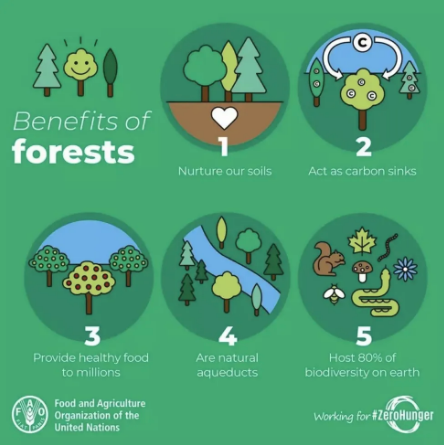|
By Douglas Broom World Economic Forum "Forests are the lungs of our land, purifying the air and giving fresh strength to our people," said former U.S. president, Franklin Roosevelt. Covering almost a third of the Earth's surface, forests are home to eight in 10 animal and plant species. The United Nations Food and Agriculture Organization (FAO) says the world's forests include over 60,000 species of tree, all of which absorb CO2 as they grow. But all is not well in Earth's woodlands. Only half of all forests are still intact and only a third are primary forest – naturally occurring woodland composed of native species where human activities have not disturbed the natural ecology. Over 20,000 tree species are at risk and over 1,400 of them are on the critical list, according to the FAO. Estimates suggest 420 million hectares of forest have been lost since 1990 and although the rate of loss has slowed, 10 million hectares were lost between 2015 and this year. So the FAO is using Twitter to remind the world of these five hidden benefits of forests. 1. Forests Nurture the Soil
As well as stabilizing soils and preventing erosion – which quickly occurs where trees are felled – forests are home to soil microbes, which together with insects, birds and mammals, play a crucial role in enriching and maintaining soil quality. 2. Forests Absorb Carbon Forests act as 'carbon sinks', trapping and storing CO2. NASA estimates that tropical forests absorb 1.4 billion tonnes of CO2 every year, while a study in 2017 estimated that forests would absorb a third of the atmospheric carbon needed to keep global warming below 2C by 2030. 3. Forests Provide Food for Millions More than 86 million people depend on forests for their livelihoods. Globally, 1 billion people rely on wild foods including meat, insects, plants, mushrooms and fish. As well as providing edible plants and protecting water sources, forests also provide shelter for animals kept by forest dwellers. 4. Forests Are Natural Aqueducts Forests provide "relatively pure water", not just for indigenous peoples, but also for some of the world's largest cities, according to the FAO. One-third of the world's metropolises get all or part of their drinking water from forest-protected areas, including Bogotá, Jakarta, Karachi, Madrid, Mumbai and Singapore. 5. Forests Host 80% of Earth's Biodiversity Forests are home to 80% of the world's animals, plants, fungi and bacteria. They include almost two-thirds of all plants, three-quarters of all birds, 80% of amphibians and 68% of mammals. The most biologically diverse and complex forests are tropical rainforests, according to the World Wide Fund for Nature, because rainfall is abundant and temperatures are consistently high. One Trillion Trees The World Economic Forum has launched an initiative to conserve, restore and grow 1 trillion trees to help curb climate change. Research has shown the importance of nature-based solutions, such as conservation, restoration and reforestation, in tackling climate change and biodiversity loss. But, these must take place alongside other measures, particularly decarbonizing industry. EcoWatch reposted with permission from World Economic Forum. In a major victory for conservation groups, a federal judge ruled that the Migratory Bird Treaty Act covers unintentional but avoidable avian deaths.
No law degree is required to get the gist of the ruling U.S. District Judge Valerie Caproni handed down on Tuesday. Sure, the decision—the latest blow to the Trump administration’s efforts to weaken environmental laws—is marbled with the typical Latin and legalese. But beginning with its opening nod to the novel To Kill a Mockingbird, Caproni’s ruling in the Southern District of New York makes it plain that the Interior Department’s interpretation of the century-old Migratory Bird Treaty Act (MBTA) isn’t merely flawed—it’s flat-out wrong. The decision strikes down a 2017 legal opinion issued by Daniel Jorjani, Interior’s top lawyer, which claimed the MBTA did not prohibit “incidental take,” a term for the unintentional but foreseeable and avoidable injury or killing of birds, often through industrial activity. For decades, the U.S. Fish and Wildlife Service (FWS) has used the threat of potential prosecution under the MBTA to convince companies to take steps to prevent killing birds, such as covering oil waste pits or marking power lines to make them more visible to birds in flight. Under Jorjani’s opinion, even mass killings of birds—such as the 2010 BP oil spill, which killed an estimated 1 million birds and resulted in a $100 million fine against the company under the MBTA—would not be punishable if killing birds wasn’t the intention. Guided by that interpretation, the FWS has opted not to investigate cases of incidental take, and even counseled companies and local governments that they need not take steps to protect birds. Caproni eviscerated that reading of the law. “It is not only a sin to kill a mockingbird, it is also a crime,” she wrote. “That has been the letter of the law for the past century. But if the Department of the Interior has its way, many mockingbirds and other migratory birds that delight people and support ecosystems throughout the country will be killed without legal consequence.” The ruling is a major win for six environmental groups and eight states whose three consolidated complaints argued that the law clearly makes it illegal to kill, hunt, capture, or attempt to capture a bird or egg without a permit “by any means or in any manner.” Caproni agreed, ruling that Interior’s position was “simply an unpersuasive interpretation of the MBTA’s unambiguous prohibition on killing protected birds.” The judge also rebuked Jorjani for issuing an opinion without tapping the expertise of federal wildlife officials. “There is no evidence of input from the agency actually tasked with implementing the statute: FWS,” she wrote. Conservationists were thrilled at the judgment’s forceful endorsement of their position. “The ruling is completely unambiguous on every count. Every rationale the government gave to try to uphold this rollback of the MBTA, the judge shot them all down,” says Erik Schneider, policy manager for the National Audubon Society, which was among the plaintiffs. “The experts had no bearing on [Jorjani’s opinion]. It was a political decision made without their input.” California Attorney General Xavier Becerra, another plaintiff, said in a statement that the ruling “recognizes the critical importance of protecting our precious wildlife and upholding the rule of law. We hope the Department of the Interior and the U.S. Fish and Wildlife Service learn their lesson and renew their commitment to acting in the best interest of the public.” People on both sides of the case expect the administration to appeal. People on both sides of the case expect the administration to appeal. “Three circuit courts have already weighed in supporting the opinion underlining the MBTA rule,” said Kathleen Sgamma, president of the Western Energy Alliance—an association of oil and gas companies that lobbied for ending enforcement of incidental take—in an email. “One district court ruling from New York will not be the final word.” Sgamma’s reference was to other MBTA cases prior to Jorjani’s opinion. Interior cited those earlier rulings as evidence that courts hadn’t settled whether the law covers incidental take and that prosecuting accidental bird deaths was therefore legally dubious. But Caproni found that line of reasoning unconvincing. “Interior’s argument vastly overstates circuit disagreement and blurs the actual boundaries that have been drawn,” she wrote. “Tensions between the circuits certainly exist, but they are not of the magnitude or kind Interior presents.” Caproni’s decision is a significant blow to Interior’s effort to enshrine Jorjani’s opinion in a formal rule, which would make the allowance of incidental take more difficult for a later administration to reverse. Part of the justification for such a reversal could come from the department’s recent draft environmental impact statement on the proposed rule, which says it is likely to push some bird species onto the endangered species list. An Interior spokesperson declined to say if the department would continue work to finalize that rule despite the court decision, instead offering an emailed statement: “Today’s opinion undermines a common sense interpretation of the law and runs contrary to recent efforts, shared across the political spectrum, to de-criminalize unintentional conduct.” Interior also declined to say how the ruling would affect day-to-day enforcement of the MBTA by the FWS. Gary Mowad, who spent 25 years with the FWS and was deputy chief of enforcement, says the agency should return to investigating industrial threats to birds and engaging companies to reduce those threats. “I hope that the Department of the Interior and the Fish and Wildlife Service take the special agents off the leash and let them do their jobs,” he says. “What I fear is that the service always has the ability to establish enforcement priorities, and they may still make this type of mortality a low enforcement priority.” To buttress Tuesday’s victory, conservationists want Congress to step in and spell out even more clearly that the MBTA does not apply only to killing birds on purpose. The Migratory Bird Protection Act, which has passed a House committee but hasn’t yet received a vote in the full chamber or a companion bill in the Senate, would affirm that the MBTA prohibits incidental take. It also would set up a permitting program whereby companies would be protected from legal action as long as they adopt industry best practices to limit harm to birds. “Congressional action could potentially build on this victory,” Schneider says, “and help provide even greater stability going forward.” https://www.audubon.org/news/court-strikes-down-trump-administration-policy-let-companies-kill-birds?ms=policy-adv-email-ea-x-engagement_20200814_advisory&utm_source=ea&utm_medium=email&utm_campaign=engagement_20200814_advisory&emci=aa2f32c2-5fde-ea11-8b03-00155d0394bb&emdi=d9ecde9c-64de-ea11-8b03-00155d0394bb&ceid=3545517 Hays Free Press
By Megan Wehring August 7, 2020 Hays County is nestled in the Texas Hill Country with incredible natural spaces. If public access isn’t always attainable, how can residents enjoy these areas during the pandemic? The Parks and Open Space Advisory Commission (POSAC) recommends the Hays County Commissioners Court call for a bond by Aug. 17. For the upcoming election in November, POSAC recommends a total bond initiative for $75 million to $80 million. Between $60 million to $65 million is looking to be used toward the tier one and tier two projects, while $15 million to $20 million could be set aside for future projects. While some residents may be concerned that the bond package would affect property taxes, POSAC Chair Scott Way ensures that the rates would stay the same. “The Commissioners Court, what we’ve heard based on the recommendations that we’ve received from their financial advisor that a bond in a range that we are recommending would not cause any increase in the tax rate,” Way said. Tier one, highly-recommended projects are of highest priority. The highest-rated project is the Coleman’s Canyon Preserve that is adjacent to the Jacob’s Well area. The Cape’s Fishing Pond property in San Marcos was bought by Hays County in March. The entire property is about 29 acres with the pond just under six acres. The proposal includes a connection to the bridge over the San Marcos River, trails around Cape’s Pond and San Marcos River trails. POSAC member Jim Camp said the project’s goal is connectivity for areas in San Marcos along with recreational access. “It looks like a great project because it has recreation,” Camp said. “It has a proposed fishing pond partnership with Texas Parks and Wildlife. It’s adjacent to, I think, a fish hatchery in San Marcos. It also scored high because it has San Marcos River access.” Urban parks are listed as some of the tier two projects. The 14,000 square foot Dripping Springs Regional Skate Park would give individuals a place for recreational activity. Patriot’s Hall, proposed to be near Dripping Springs, would give a 10-acre retreat for all veterans and their families. There would be about 60% to 70% green space available for campouts, cookouts and fitness challenges. The next Commissioners Court’s meeting is Aug. 11 with a possible agenda item of discussing the bond initiative. Read the Hays Free Press article. |
Contact UsFollow us on Facebook and YouTube
|






